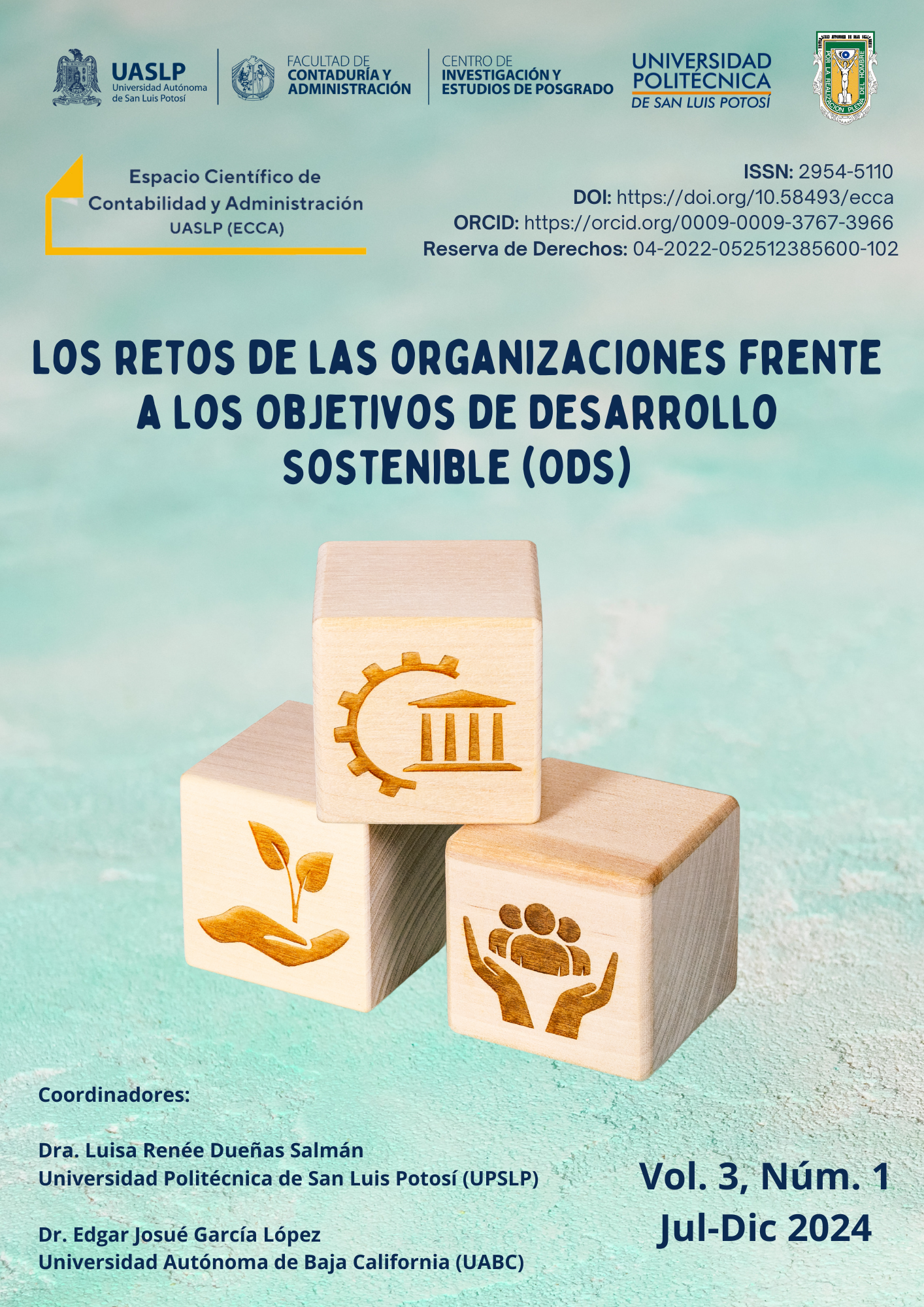La diversidad de género en los consejos como estrategia de sostenibilidad para prevenir el fraude corporativo
The gender diversity on boards as a sustainability strategy to prevent corporate fraud
DOI:
https://doi.org/10.58493/ecca.2024.3.1.13Palabras clave:
Gobierno corporativo, Fraude corporativo, Género, Latinoamérica, Corporate Governance, Corporate Fraud, Gender, Latin AmericaResumen
La diversidad de género es un tema de gran relevancia en el ámbito empresarial actual. La participación de las mujeres en posiciones de liderazgo es un elemento clave para el desarrollo de empresas dada su influencia en diversas áreas de desempeño financiero y de gobernanza. El presente estudio presenta una exploración de la literatura respecto al fraude corporativo, así como la relación entre la presencia femenina y la comisión de actos de fraude dentro de las compañías. En específico se realizó una recopilación de informes de gobernanza, la participación de mujeres y actos de fraude en empresas cotizadas latinoamericanas entre los años 2008 y 2022 conformando un total de 1,431 observaciones, cuya primera aproximación se realizó mediante un estudio estadístico descriptivo.
Citas
Adams, R.B., Haan, J D., Terjesen, S., & Ees, H V. (2015). Board Diversity: Moving the Field Forward. Corporate Governance: An International Review, 23(2), 77-82. https://doi.org/10.1111/corg.12106
Agrawal, A., & Chadha, S. (2005). Corporate governance and accounting scandals. Journal of Law and Economics, 48(2), 371–406.
Alvarado, N R., Ruiz, P D F., & Briones, J L. (2015). Does Board Gender Diversity Influence Financial Performance? Evidence from Spain. Journal of Business Ethics, 141(2), 337-350. https://doi.org/10.1007/s10551-015-2735-9
Arnaboldi, F., Casu, B., Gallo, A., Kalotychou, E., & Sarkisyan, A. (2021). Gender diversity and bank misconduct. Journal of Corporate Finance, 71, 101834-101834. https://doi.org/10.1016/j.jcorpfin.2020.101834
Armstrong, C. S., Core, J. E., & Guay, W. R. (2014). Do independent directors cause improvements in firm transparency? Journal of Financial Economics, 113(3), 383–403. https://doi.org/10.1016/j.jfineco.2014.05.009
Baum, I., Gafni, D., & Lazar, R L L. (2022). Gender and Corporate Crime: Do Women on the Board of Directors Reduce Corporate Bad Behavior?. https://doi.org/10.36641/mjgl.29.2.gender.
Bar-Hava, K., Huang, S. Z., Segal, B., & Segal, D. (2021). Do outside directors tell the truth, the whole truth and nothing but the truth when they resign? Journal of Accounting, Auditing & Finance, 36(1), 3–29. https://doi.org/10.1177/0148558X18780801
Beasley, M. S. (1996). An empirical analysis of the relation between the board of director composition and financial statement fraud. Accounting Review, 71(4), 443–465.
Burns, N., & Kedia, S. (2006). The impact of performance-based compensation on misreporting. Journal of Financial Economics, 79(1), 35–67. Retrieved from https://ideas.repec.org/a/eee/jfinec/v79y2006i1p35-67.html
Burns, N., & Kedia, S. (2008). Executive option exercises and financial misreporting. Journal of Banking and Finance, 32(5), 845–857.
Briano-Turrent, G.C..(2014). Factores que Inciden en una mayor transparencia de gobernanza corporativa en empresas cotizadas Latinoamericanas. https://scite.ai/reports/10.21919/remef.v9i2.58.
Carter, D A., Simkins, B J., & Simpson, W. (2003). Corporate Governance, Board Diversity, and Firm Value. The Financial Review, 38(1), 33-53. https://doi.org/10.1111/1540-6288.00034
Cumming, D J., Leung, T Y., & Rui, O M. (2015). Gender Diversity and Securities Fraud. Academy of Management Journal, 58(5), 1572-1593. https://doi.org/10.5465/amj.2013.0750
Conyon, M. J., & He, L. (2016). Executive compensation and corporate fraud in China. Journal of Business Ethics, 134(4), 669–691. https://doi.org/10.1007/s10551-014-2390-6
Chen, G., Crossland, C., & Huang, S. (2016). Female board representation and corporate acquisition intensity. Strategic Management Journal, 37(2), 303–313.
Chen, D., Wang, F., & Xing, C. (2020). Financial reporting fraud and CEO pay-performance incentives. Journal of Management Science and Engineering. https://doi.org/10.1016/j.jmse.2020.07.001
Chunli, Liu, Lui Y. Weibo. G. (2023). MuST: An interpretable multidimensional strain theory model for corporate misreporting prediction. Electronic Commerce Research and Applications. Vol. 57. https://doi.org/10.1016/j.elerap.2022.101225
Christian et al., (2019). Analysis of Fraud Triangle, Fraud Diamond and Fraud Pentagon Theory to Detecting Corporate Fraud in Indonesia. The International Journal of Business management and Technology, 3(4), 1-6.
Cressey, Donald R. (1953). Other People´s Money. Glencoe, IL: Free Press
Dechow, P. M., Ge, W., Larson, C. R., & Sloan, R. G. (2011). Predicting material accounting misstatements. Contemporary Accounting Research, 28(1), 17–82.
Desai, H., Hogan, C. E., & Wilkins, M. S. (2006). The reputational penalty for aggressive accounting: Earnings restatements and management turnover. Accounting Review, 81(1), 83–112.
Durkheim, E. (1965). The division of labour in society. New York, The Free Press.
Efendi, J., Srivastava, A., & Swanson, E. P. (2007). Why do corporate managers misstate financial statements? The role of option compensation and other factors. Journal of Financial Economics, 85(3), 667–708.
Efrizal, S. Dovi, S. (2021). Corruption from fraud theory perspective. Jurnal Akuntansi, Ekonomi dan Manajemen Bisnis Vol. 9 No. 2.
Fairchild, R., Gwilliam, D., & Marnet, O. (2019). Audit Within the Corporate Governance Paradigm: A Cornerstone Built on Shifting Sand? British Journal of Management, 30(1), 90–105. https://doi.org/10.1111/1467-8551.12297
Faccio, M., Marchica, M.-T., & Mura, R. (2016). CEO gender, corporate risk-taking, and the efficiency of capital allocation. Journal of Corporate Finance, 39, 193-209. doi:10.1016/j.jcorpfin.2016.02.008
Fama, E. F., & Jensen, M. C. (1983). Separation of ownership and control. Journal of Law and Economics, 26(2), 301–325.
Francœur, C., Labelle, R., & Sinclair‐Desgagné, B. (2007). Gender Diversity in Corporate Governance and Top Management. Journal of Business Ethics, 81(1), 83-95. https://doi.org/10.1007/s10551-007-9482-5
Ghaeli, M R. (2019). The role of gender in corporate governance: A state-of-art review. Accounting, 31-34. https://doi.org/10.5267/j.ac.2018.6.002
Gbegi, D. O and Adebisi, J. F (2013). The New Fraud Diamond Model-How Can It Help Forensic Accountants in Fraud Investigation in Nigeria? European Journal of Accounting Auditing and Fiancé Research, 1(4), 129-138.
Haß, L. H., Müller, M. A., & Vergauwe, S. (2015). Tournament incentives and corporate fraud. Journal of Corporate Finance, 34, 251–267. https://doi.org/10.1016/j.jcorpfin.2015.07.008
Hayek, C. C., & Atinc, G. (2018). Corporate Fraud: Does Board Composition Matter? Journal of Accounting and Finance, 18(2), 10–25.
Heminway, J M. (2006). Sex, Trust, and Corporate Boards. Social Science Research Network. https://doi.org/10.2139/ssrn.924590
Hemraj, M. B. (2004). Preventing corporate scandals. Journal of Financial Crime, 11, 268-276. https://doi.org/10.1108/13590790410809202
Huq, U R. (2020). Corporate Fraud, Board Gender Diversity and Stock Market Reaction.
Jan, C.-L. Detection of Financial Statement Fraud Using Deep Learning for Sustainable Development of Capital Markets under Information Asymmetry. Sustainability 2021, 13, 9879. https:// doi.org/10.3390/su13179879
Johnson, S G., Schnatterly, K., & Hill, A. (2012). Board Composition Beyond Independence. Journal of Management, 39(1), 232-262. https://doi.org/10.1177/0149206312463938
Johnson, S. A., Ryan, H. E., & Tian, Y. S. (2009). Managerial incentives and corporate fraud: The sources of incentives matter. Review of Finance, 13(1), 115–145.
Jurkus, A F., Park, J C., & Woodard, L S. (2011). Women in top management and agency costs. Journal of Business Research, 64(2), 180-186. https://doi.org/10.1016/j.jbusres.2009.12.010
Kashirskaya L., Poquioma Tulumba Miguel Аngel, Karabasheva M., Khoruzhy L., 2020. Diagnostics of corporate fraud and counteraction measures. Journal of Security and Sustainability Issues, 9(3), 1511-1522. https://doi.org/10.9770/jssi.2020.9.3(32)
Kassem, R. (2022). Elucidating corporate governance’s impact and role in countering fraud. https://scite.ai/reports/10.1108/cg-08-2021-0279
Kim, J. Y., Roden, D. M., & Cox, S. R. (2013). The composition and compensation of the board of directors as predictors of corporate fraud. Accounting and Finance Research, 2(3), 142–154. https://doi.org/10.5430/afr.v2n3p142
Khanna, V., Kim, E. H., & Lu, Y. (2015). CEO Connectedness and Corporate Fraud. Journal of Finance, 70(3), 1203–1252. https://doi.org/10.1111/jofi.12243
Kong, D., Xiang, J., Zhang, J., & Lu, Y. (2019). Politically connected independent directors and corporate fraud in China. Accounting & Finance, 58(5), 1347–1383. https://doi.org/10.1111/acfi.12449
Lai, T., Lei, A. C. H., & Song, F. M. (2019). The impact of corporate fraud on director-interlocked firms: Evidence from bank loans. Journal of Business Finance & Accounting, 46(1–2), 32–67. https://doi.org/10.1111/jbfa.12362
Lanis, R., & Richardson, G. (2018). Outside directors, corporate social responsibility performance, and corporate tax aggressiveness: An empirical analysis. Journal of Accounting, Auditing & Finance, 33(2), 228–251. https://doi.org/10.1177/0148558X16654834
Li, X., Kim, J. B., Wu, H., & Yu, Y. (2019). Corporate Social Responsibility and Financial Fraud: The Moderating Effects of Governance and Religiosity. Journal of Business Ethics, 1–20. https://doi.org/10.1007/s10551-019-04378-3
Liao, J., Smith, D., & Liu, X. (2019). Female CFOs and accounting fraud: Evidence from China. Pacific- Basin Finance Journal, 53, 449–463. https://doi.org/10.1016/j.pacfin.2019.01.003
Luo, J.-h., Peng, C., & Zhang, X. (2020). The impact of CFO gender on corporate fraud: Evidence from China. Pacific-Basin Finance Journal, 63, 101404. https://doi.org/10.1016/j.pacfin.2020.101404
Martínez-García, I., Sacristán-Navarro, M., & Gómez-Ansón, S. (2020). Diversidad de género en los consejos de administración: El efecto de la normativa en la presencia de mujeres en las empresas españolas cotizadas. https://scite.ai/reports/10.7263/adresic-022-03
Maulidi, A. (2022). Gender board diversity and corporate fraud: empirical evidence from US companies. https://scite.ai/reports/10.1108/jfc-02-2022-0038
Martins, O. S., & Júnior, R. V. (2020). The influence of corporate governance on the mitigation of fraudulent financial reporting. Revista Brasileira de Gestao de Negocios, 22(1), 65–84. https://doi.org/10.7819/rbgn.v22i1.4039
Merton, R. K. (1938). Social Structure and Anomie. American Sociological Review, 3(5), 672–682. https://doi.org/10.2307/2084686
ONU Mujeres (2024). Las mujeres y los objetivos de desarrollo sostenible. Obtenido de: https://www.unwomen.org/es/news/in-focus/women-and-the-sdgs/sdg-5-gender-equality
Pucheta‐Martínez, M C., & Bel‐Oms, I. (2015). The board of directors and dividend policy: the effect of gender diversity. Industrial and Corporate Change, 25(3), 523-547. https://doi.org/10.1093/icc/dtv040
Pucheta‐Martínez, M C., Bel‐Oms, I., & Olcina‐Sempere, G. (2018). The association between board gender diversity and financial reporting quality, corporate performance and corporate social responsibility disclosure. Academia, 31(1), 177-194. https://doi.org/10.1108/arla-04-2017-0110
Rao, K K., & Tilt, C. (2015, March 17). Board Composition and Corporate Social Responsibility: The Role of Diversity, Gender, Strategy and Decision Making. Journal of Business Ethics, 138(2), 327-347. https://doi.org/10.1007/s10551-015-2613-5
Rashid, Al-Mamun, Roudaki & Yasser. (2022). An Overview of Corporate Fraud and its Prevention Approach. AABFJ. Volume 16, No.1
Reddy, S., & Jadhav, A. (2019). Gender diversity in boardrooms – A literature review. Cogent economics & finance, 7(1), 1644703-1644703. https://doi.org/10.1080/23322039.2019.1644703
Rodríguez, B R., Demmler, M., & Zamora, L A R. (2023). Diversidad de género y desempeño financiero en empresas bursátiles mexicanas. https://scite.ai/reports/10.17163/ret.n25.2023.10
Ruankaew, T (2016). Beyond the Fraud diamond. International Journal of Business Management and Economic Research (IJBMER), 7(1), 474-476.
Suh, I., Sweeney, J. T., Linke, K., & Wall, J. M. (2020). Boiling the Frog Slowly: The Immersion of C-Suite Financial Executives into Fraud. Journal of Business Ethics, 162(3), 645–673. https://doi.org/10.1007/s10551-018-3982-3
Sujana et al., (2018). Testing of Fraud Diamond Theory Based on Local Wisdom on Fraud Behavior. Advances in economics, business and Management Research, 69(1), 12-15.
Sutherland, Edwin H. (1939). Principles of criminology. 3ed Philadelphia: Lippin-cott
Teodósio, J., Vieira, E., & Madaleno, M. (2021). Gender diversity and corporate risk-taking: a literature review. Managerial Finance, 47(7), 1038-1073. https://doi.org/10.1108/mf-11-2019-0555
Wahid, A S. (2016). The Effects and the Mechanisms of Board Gender Diversity: Evidence from Financial Reporting Misconduct. Social Science Research Network. https://doi.org/10.2139/ssrn.2930132
Vaughan, D. (1999). The dark side of organizations: mistakes, misconduct, and disaster. Annual Review of Sociology, 25, 271-305.
Vousinas, G. L. (2019). “Advancing theory of fraud: the S.C.O.R.E. model,” J. Financ. Crime , vol. 26, no. 1, pp. 372 381.
Wahid, A S. (2018). The Effects and the Mechanisms of Board Gender Diversity: Evidence from Financial Manipulation. Journal of Business Ethics, 159(3), 705-725. https://doi.org/10.1007/s10551-018-3785-6
Wang, Y., Maemura, Y., & Gao, S S. (2022). Gender diversity and financial statement fraud. https://doi.org/10.1016/j.jaccpubpol.2021.106903
Wolfe and D. Hermanson. (2004). The Fraud Diamond: Considering the Four Elements of Fraud. CPA J. J., vol. 74, pp. 38 42.
Xu, Y., Zhang, L., & Chen, H. (2018). Board age and corporate financial fraud: An interactionist view. Long Range Planning, 51, 815-830. https://doi.org/10.1016/j.lrp.2017.08.001
Zahra, S., Priem, R., and Rasheed, A. (2007). Understanding the causes and effects of top management fraud. Organizational Dynamics, 36 (2), 122 - 139.

Descargas
Publicado
Número
Sección
Categorías
Licencia
Derechos de autor 2025 OSMAR AXEL CERVANTES CABRERA

Esta obra está bajo una licencia internacional Creative Commons Atribución-NoComercial-CompartirIgual 4.0.
Usted es libre de:
- Compartir — copiar y redistribuir el material en cualquier medio o formato
- Adaptar — remezclar, transformar y construir a partir del material
- La licenciante no puede revocar estas libertades en tanto usted siga los términos de la licencia
Bajo los siguientes términos:
- Atribución — Usted debe dar crédito de manera adecuada , brindar un enlace a la licencia, e indicar si se han realizado cambios . Puede hacerlo en cualquier forma razonable, pero no de forma tal que sugiera que usted o su uso tienen el apoyo de la licenciante.
- NoComercial — Usted no puede hacer uso del material con propósitos comerciales .
- CompartirIgual — Si remezcla, transforma o crea a partir del material, debe distribuir su contribución bajo la la misma licencia del original.
- No hay restricciones adicionales — No puede aplicar términos legales ni medidas tecnológicas que restrinjan legalmente a otras a hacer cualquier uso permitido por la licencia.










